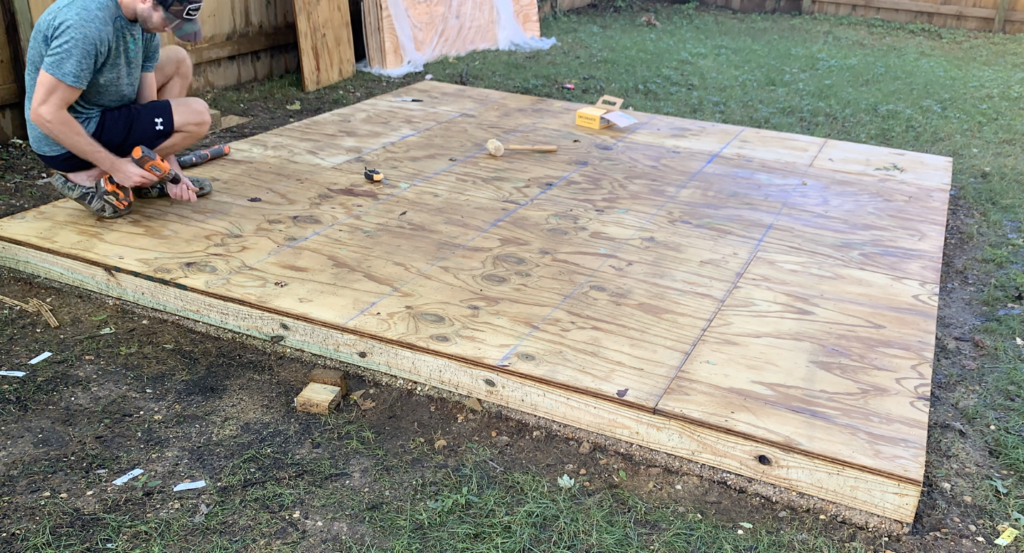
The key to building shed that will last for decades is to start by constructing a solid shed floor base. Building a shed floor base is simple, but it needs to be done correctly in order to set the correct foundation for the rest of your shed build. There are many different ways to build a shed floor base, but 4″x4″ pressure treated floor joist lumber will guarantee a durable shed floor base that will last for years.
To build a shed floor base with pressure treated 4″x4″ lumber, start by positioning your floor joists so that that the edges of the plywood subfloor will land directly in the center of your shed floor joists. Space your floor joists approximately 12″-16″ on center, or as required based on the thickness of your subfloor. Next, attach a pressure treated 2″x4″ end cap to the front and back of the shed base frame, perpendicular to the shed floor joists. Finally, attach the plywood subfloor to the shed floor joists.
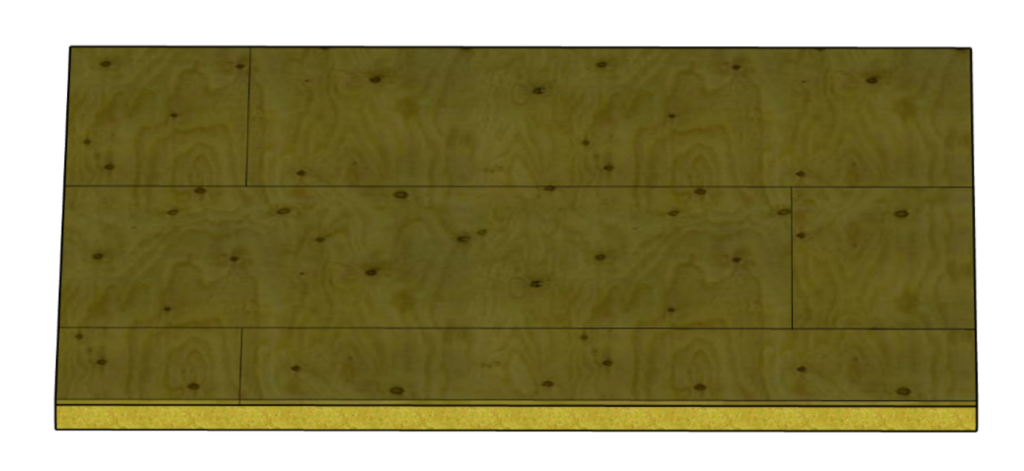
Overall, building a shed floor base is a relatively simple step in the shed building process. With a bit of planning and preparation, you can ensure that you set up a solid shed base foundation for the rest of your shed build.
Tools and Materials Needed to Build a Shed Floor Base
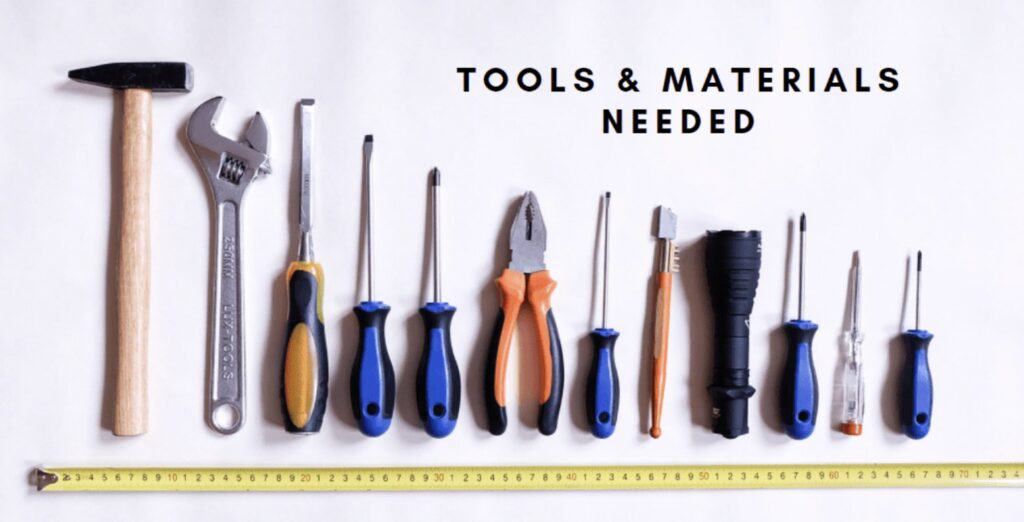
To successfully build a shed floor base using 4″x4″ floor joist lumber, you will need the following tools and materials:
- Safety Equipment (Glasses, gloves, boots, etc.)
- Tape Measure
- Drill
- Exterior Screws
- Circular Saw OR Miter Saw
- Air Compressor
- Framing Nailer
- Exterior Framing Nails (for nail gun)
- Pressure Treated 4″x4″x10′ lumber
- Pressure Treated 2″x4″x10″ lumber
- Pressure Treated 4’x8′ plywood
With all necessary tools and materials on hand, you can now begin constructing your shed floor base.
1. Determine the Size of your Shed Floor Base
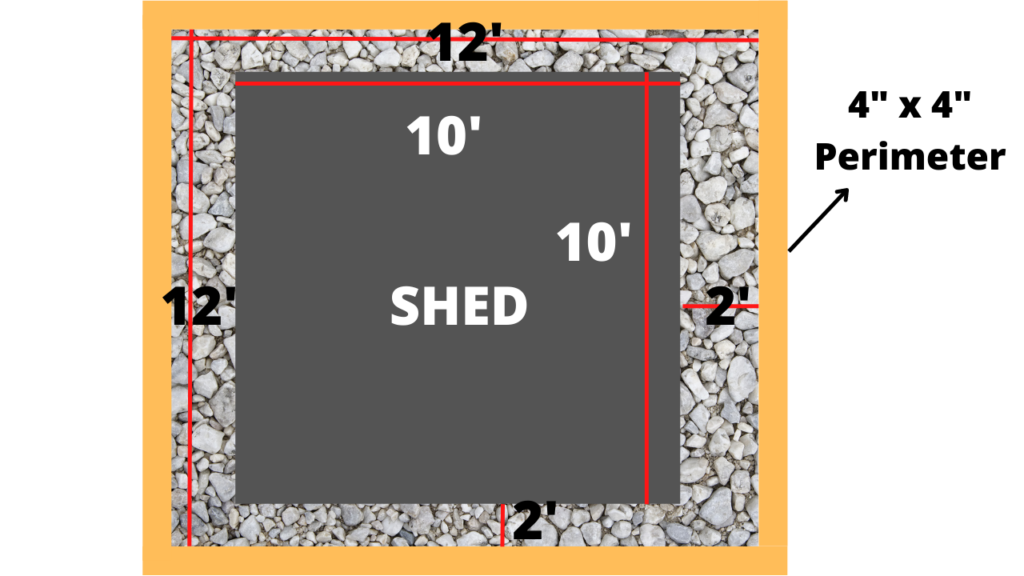
Although this goes without saying, you need to determine the size your shed before you can construct the shed floor base for it. For the purposes of this article, we will be constructing a 10’x10′ shed floor base. If you are building a different size shed, you can modify these instructions slightly in order to accommodate your specific shed size.
After determining your shed floor base size, you can start to layout the shed base floor joist spacing.
2. Determine Your Shed Base Floor Joist Spacing
When determining your 4″x4″ floor joist spacing, you want to ensure that that edges of your plywood subfloor (to be installed in later steps) will rest directly in the center of the floor joists below. Typically, this will be 16″ O.C. (on center) spacing. Spend some time thinking about how you will need to space your shed base floor joists so that the plywood subfloor will be properly supported.
For a 10’x10′ shed, the following floor joist spacing will allow for the 4’x8′ plywood subfloor to land directly in the center of the joist – as indicated by the red “X’s” below.
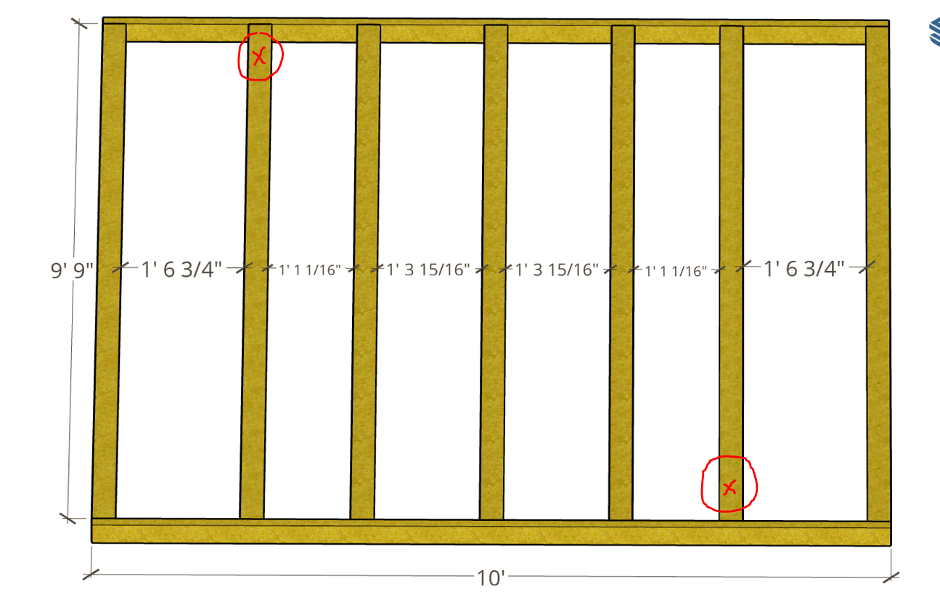
The figure below gives a preview of what the 10’x10′ shed floor base will look like once the plywood subfloor is installed.
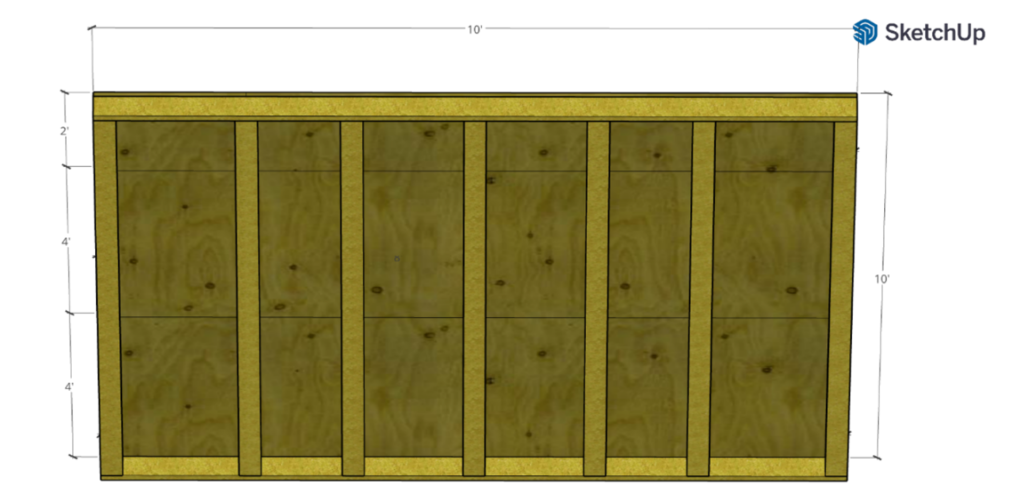
Consider using graph paper or a 3D modeling software like Sketchup to model the shed base frame and the associated floor joist spacing. Again, the floor joists should be positioned such that the edges of plywood subfloor land directly in the center of the floor joists.
For a 10’x10′ shed base, seven (7) 4″x4″x10′ pressure treated floor joists are required in order to provide sufficient support for the plywood subfloor. Additionally, two pieces of 2″x4″x10′ pressure treated lumber will be needed for the end caps that run perpendicular to the floor joists. A sample 10’x10′ floor joist and end cap layout is shown below:
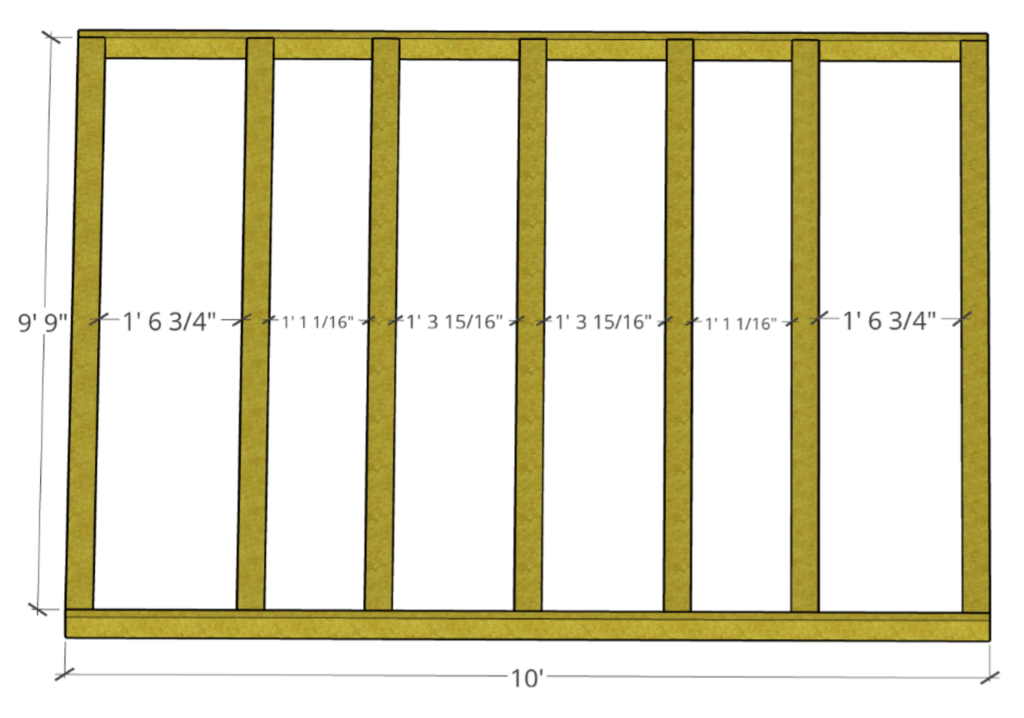
3. Layout The Shed Floor Base Frame
After determining the shed’s floor joist spacing, trim the 2″x4″x10′ end caps to the required length (10′, in this case). Next, mark the joist spacing on the both end caps at the same time using a pencil.
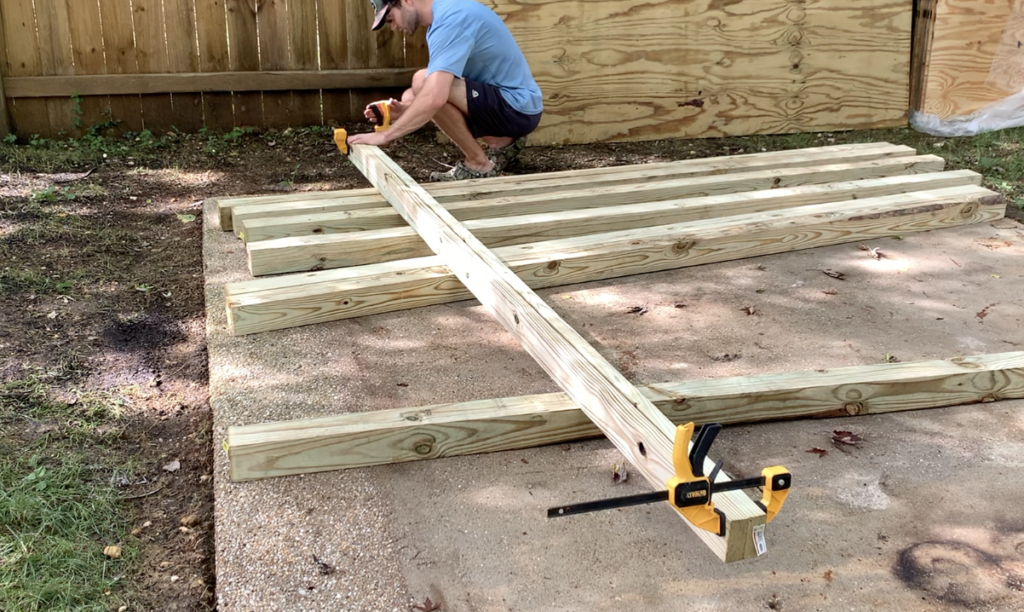
By marking both end caps at the same time, you will easily be able to position you floor joists in the correct location.
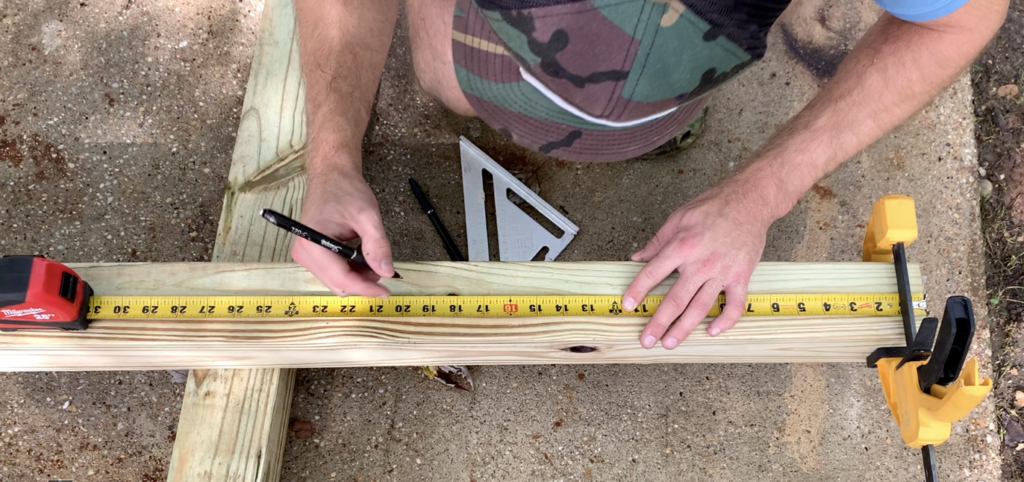
Mark each shed base floor joist location on the end caps as required to ensure that the edges of the plywood subfloor will land directly in the center of a floor joist. For a 10’x10′ shed floor base, consider marking the end caps with floor joist spacing as shown below:
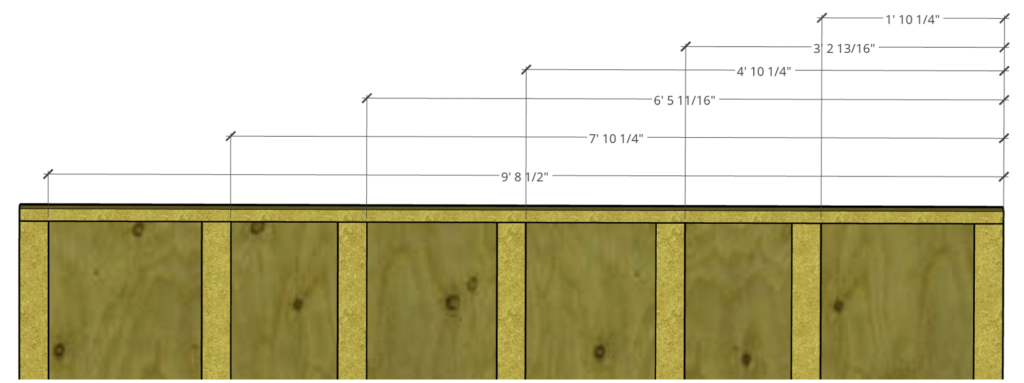
Next, cut the 4″x4″ floor joists to length. For a 10’x10′ shed, cut the joists to a length of 9′-9″. Once you attach both end caps (1.5″ +1.5″), you will have a 10’x10′ square shed base.
Position your end caps in place and begin positioning your 4″x4″ floor joists perpendicular to the end caps at the locations of the shed base floor joist markings made previously. Once you have positioned your end caps and floor joists in place, you shed floor base frame should look like this:
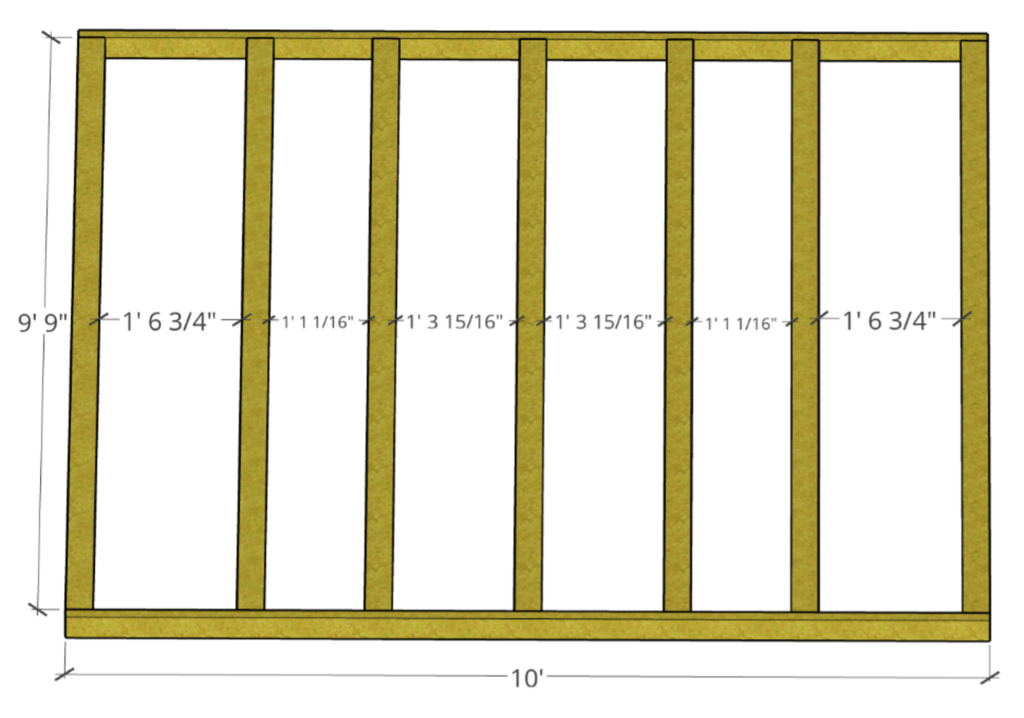
4. Attach the Shed Base Frame Together
After laying out the shed base floor joists and end caps, attach the 4″x4″ floor joists to the 2″x4″ end caps using exterior rated screws or galvanized nails. Two screws (or nails) per connection is recommended.

PRO TIP: Attach the shed floor joists to the end caps by screwing through the end cap and into the floor joists. 3.5″ screws or nails are recommended. You may also attach the joists to the end cap by “toe-nailing” nails though the 4″x4″ floor joist and into the end cap.
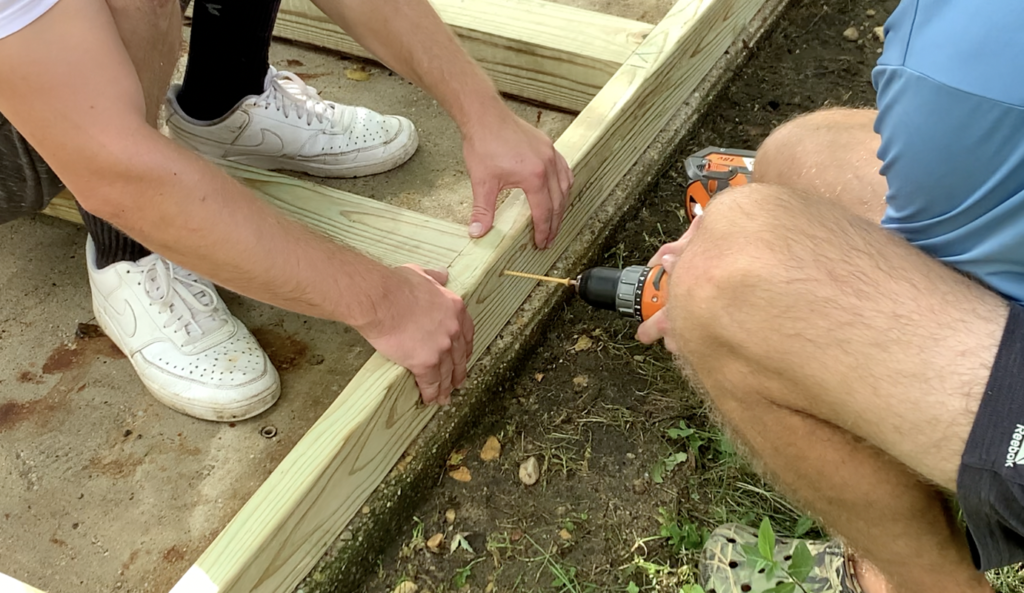
After securing each shed floor joist to the end cap, you can proceed to the next step of the shed floor base construction process.
5. Square the Shed Floor Base Frame
After attaching the floor joists to the end caps, square the shed base frame to ensure that the plywood subfloor will fit appropriately. To square the shed, use a tape measure to compare the distance from each set of opposite corners. If the measurements are the same, the shed floor base frame is square. If the measurements differ, adjust the frame as needed until the measurements from each set of opposite corners is the same.
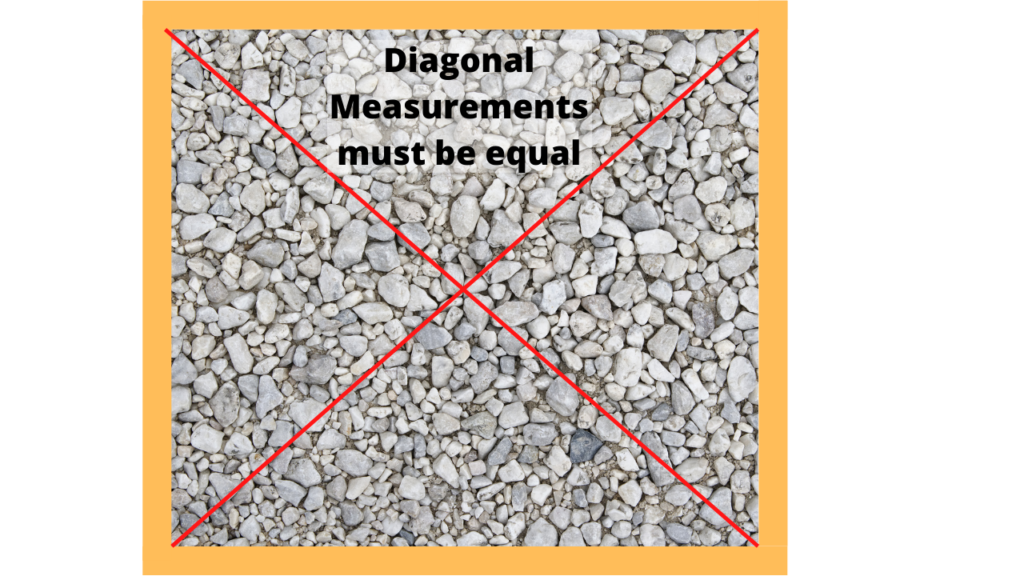
6. Anchor the Shed Floor Base to the Concrete Slab below (optional)
In high wind areas, it is often a code requirement to secure your shed to the concrete slab below. Consult with your local code requirements as needed.
To attach your 4″x4″ shed floor base Frame to a concrete slab, it is recommended that you install a piece of 2″x4″ pressure treated blocking in between a few of your floor joists – as shown below:
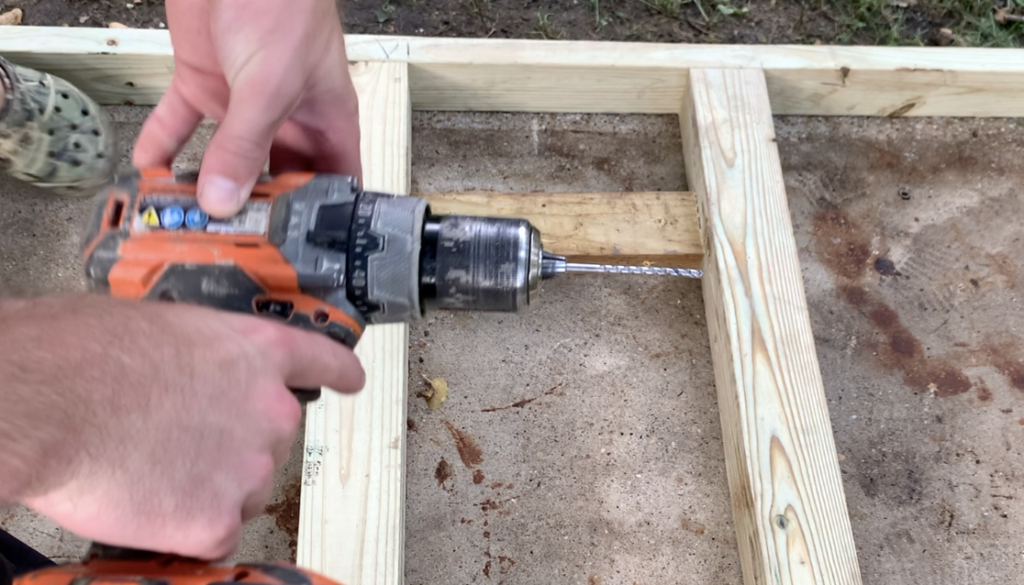
After attaching the blocking to the floor joists with exterior rated screws or galvanized nails, pre-drill through the blocking and into the concrete slab using a masonry bit and a hammer drill. Ensure that you drill at least 1.5″ into the concrete slab with the masonry bit.
Next, use a Tapcon concrete screw to drill though the blocking and into the concrete slab – effectively securing the shed base to the slab.
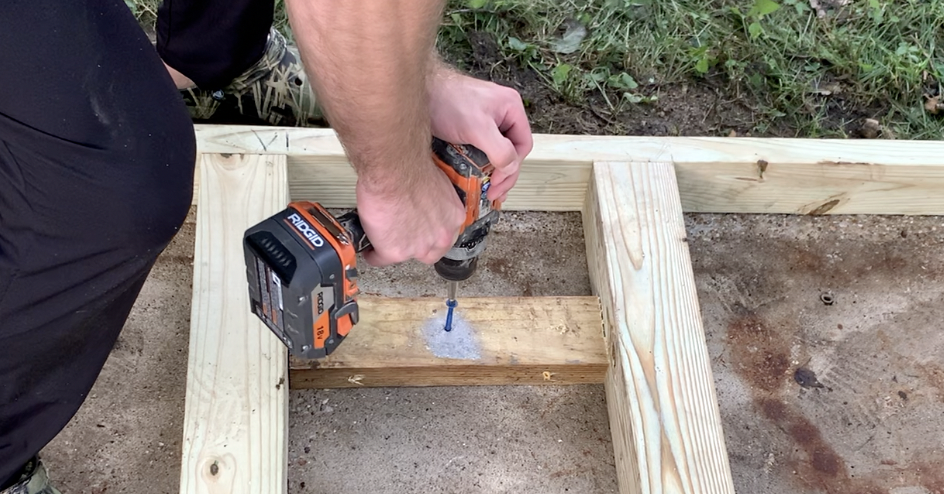
PRO TIP – Ensure that you coordinate your masonry bit and masonry (Tapcon) screw sizes accordingly. Typically, the masonry bit will be slightly smaller in diameter than the Masonry screw used. Check the Tapcon / Masonry screw packaging to determine what size pre-drilled hole is needed.
Repeat this process for as many anchor locations into the slab as you desire (or as code requires).
7. Attach the Plywood Subfloor to the Shed Base Frame
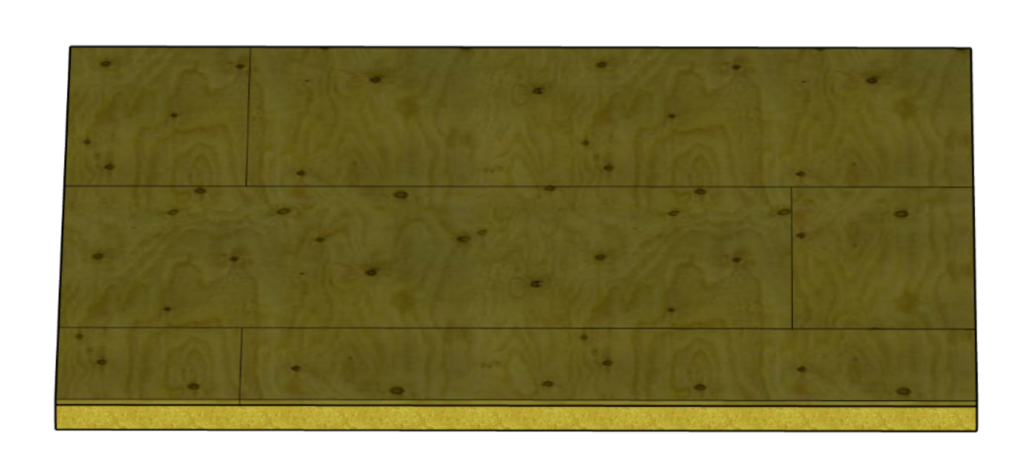
After confirming that the Shed floor Base frame is perfectly square, you can begin installing your plywood subfloor.
For most shed bases, pressure treated plywood makes for the best shed subfloor material. Because your joists will inevitably get wet, it is best practice to use a pressure treated subfloor in order to maximize the lifetime of your shed. Although standard plywood is also acceptable, it is not nearly as durable as pressure treated plywood in this application.
PRO TIP – Avoid using OSB for your shed subfloor. OSB swells and degrades when exposed to moisture – making it the worst subfloor option for you shed floor base.
If you planned out your joist spacing carefully, installing the shed subfloor should be a very straightforward process.
Use full sheets of 4’x8′ pressure treated plywood and position the plywood in place upon the shed base frame. The edge of each piece of plywood should land in the center of the floor joists. Position the first sheet of plywood so that it is flush with the shed base frame and also in the center of a floor joist. Next, attach the plywood to the joists and end cap using exterior rated screws or galvanized nails every 12″ O.C.
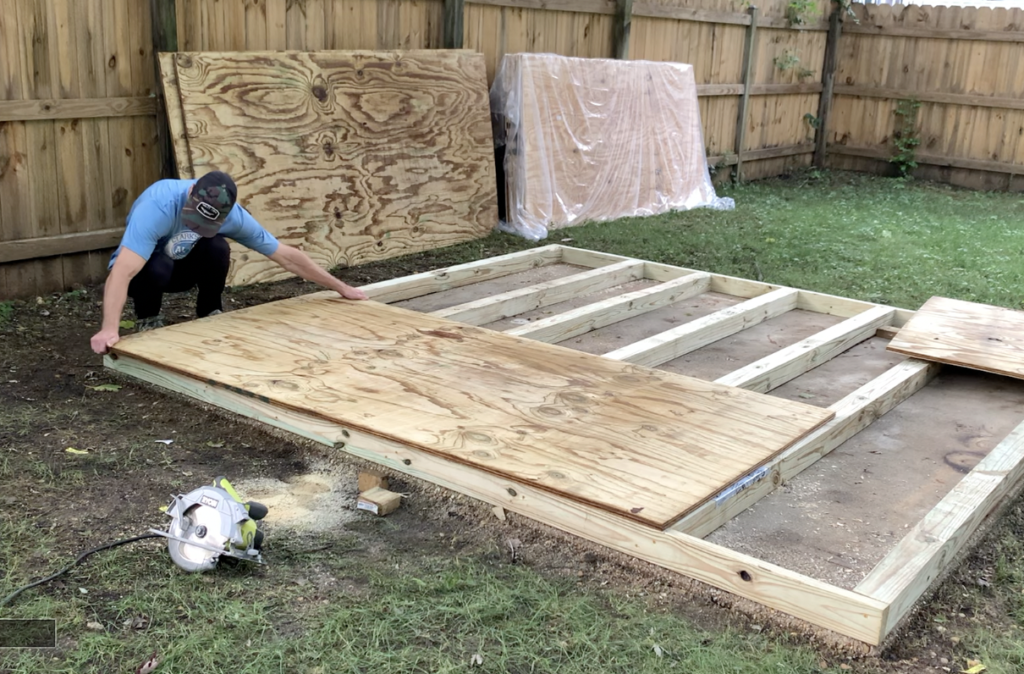
Continue to position plywood in place on top of the shed base frame until the entire frame is covered by a the plywood subfloor.
PRO TIP – Consider marking the joist locations on each end cap and then using a chalk line to establish the joist location on the plywood subfloor. This may make it easier to identify the exact joist location when attaching the plywood subfloor the the shed base frame below.
It is generally good practice to leave a slight expansion gap (1/8″) between each sheet of the shed’s plywood subfloor. However, pressure treated lumber typically shrinks once it dries out. Therefore, it is also common for pressure treated plywood to be butted up right next to the adjacent sheet (with the expectation that the plywood sheet will shrink over time).
Continue to install plywood until the entire shed base frame has been covered by the subfloor. For a 10’x10′ shed, you will have a plywood subfloor arrangement similar to what is shown below:
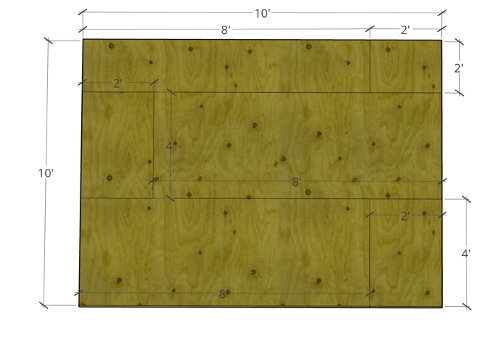
For the smaller sections of plywood subfloor, use a chalk line to establish the cut line and then trim the plywood subfloor to size using a circular saw.
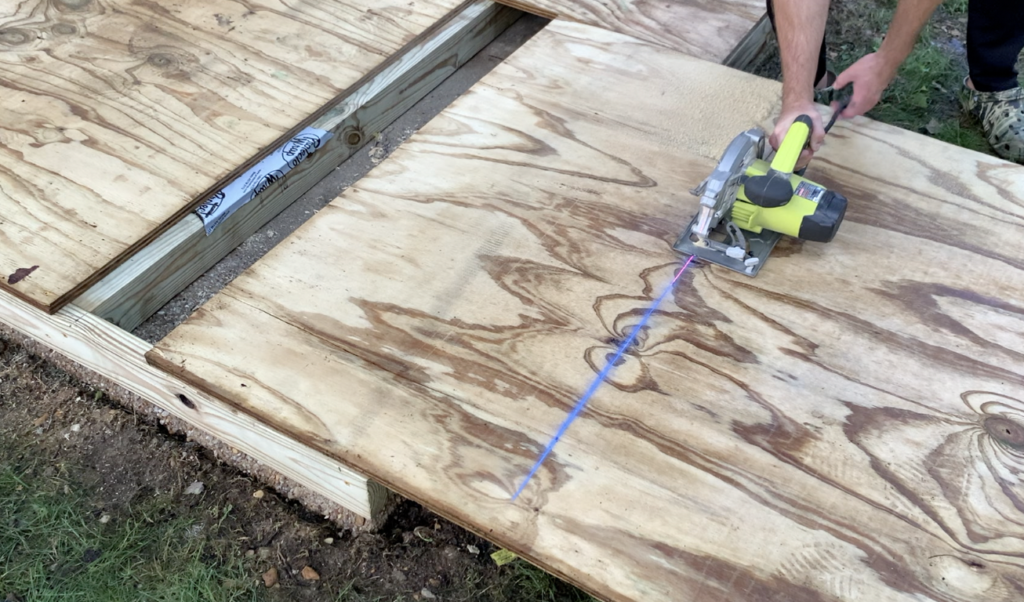
After securing your plywood subfloor to the the shed base frame below, your shed base frame is complete. You can now move on to the next step in the Shed Building Process – Framing the Walls.

If you want to learn how to build the Modern Shed you see below, Check out my “How to Build a Modern Shed Course” Linked Here. This Course includes a detailed materials list, tools lists, lumber cut lists, and step-by-step video instructions for each step of the project!

For more information on how to Build a 10’x10 Modern Shed from start to finish, check out ATimprovements.com or watch my step-by-step tutorial videos on Youtube. Thanks!
Thanks so much for checking out ATImprovements! If you learned something from this project, you might also like these other DIY Projects:
- How to Build a Concrete Slab Shed Foundation: https://atimprovements.com/how-to-build-a-shed-base-concrete-slab-step-by-step-diy-guide/
- How to Build a Fence: How to Build a Fence (DIY Guide) – AT Improvements
- How to Build a Fence Gate: How to Build a Fence Gate (7 Steps with Pictures & Video) – AT Improvements
- How to Install a DIY deck Wire Railing: DIY Cable Railing – How to Install Cable Railing Step-by-Step – (atimprovements.com)
- How to Build a Concrete Paver Patio: DIY PAVER PATIO – Easy DIY Paver Patio Ideas – (atimprovements.com)
Thanks!
DISCLAIMER: This is a reference guide only. Consult local code requirements. Links included in this article might be affiliate links. If you purchase a product or service with the links that I provide, I may receive a small commission. There is no additional charge to you! Thank you for supporting ATimprovements so I can continue to provide you with free content each week!
